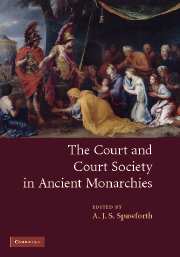Book contents
- Frontmatter
- Contents
- List of figures
- List of tables
- Notes on contributors
- Acknowledgements
- List of abbreviations
- Introduction
- 1 New out of old? Court and court ceremonies in Achaemenid Persia
- 2 King, court and royal representation in the Sasanian empire
- 3 The court of Alexander the Great between Europe and Asia
- 4 Friends in high places: the creation of the court of the Roman emperor
- 5 The imperial court of the late Roman empire, C. AD 300–C. AD 450
- 6 The imperial court in Han China
- 7 Court and palace in ancient Egypt: the Amarna period and later Eighteenth Dynasty
- Bibliography
- Index
5 - The imperial court of the late Roman empire, C. AD 300–C. AD 450
Published online by Cambridge University Press: 22 September 2009
- Frontmatter
- Contents
- List of figures
- List of tables
- Notes on contributors
- Acknowledgements
- List of abbreviations
- Introduction
- 1 New out of old? Court and court ceremonies in Achaemenid Persia
- 2 King, court and royal representation in the Sasanian empire
- 3 The court of Alexander the Great between Europe and Asia
- 4 Friends in high places: the creation of the court of the Roman emperor
- 5 The imperial court of the late Roman empire, C. AD 300–C. AD 450
- 6 The imperial court in Han China
- 7 Court and palace in ancient Egypt: the Amarna period and later Eighteenth Dynasty
- Bibliography
- Index
Summary
I, [an obelisk], reluctant once, am [now] commanded to obey the Lords serene … [for] everything yields to Theodosius and to his everlasting offspring; hence I am conquered and mastered and raised up into the high sky.
(Inscription on an obelisk-base in the Hippodrome adjoining the Great Palace at Constantinople, c. AD 390 (ILS 821))O Emperor Augustus [Theodosius], if ever there was any one who was justifiably in fear and trembling when about to speak in your presence, I am assuredly he; I both feel it so myself, and perceive that this is how I must seem to those who share in your council at court.
Pacatus, Panegyric of Theodosius, AD 389 (Pan.Lat.II.1)‘We saw in the papers that you had had a long talk with King Theodosius,’ my father ventured. ‘Why, yes – the King, who has a wonderful memory for faces, was kind enough to remember, when he noticed me in the stalls, that I had had the honour to meet him on several occasions at the Court … An aide-de-camp came down to bid me pay my respects to His Majesty, whose command I naturally hastened to obey.’
(M. Proust, A l'ombre des jeunes filles en fleurs (trans. C. K. Scott Moncrieff))The imperial court in the late Roman state: ‘absolutism’, imperial ‘decline’ and the notion of ‘the court society’
- Type
- Chapter
- Information
- The Court and Court Society in Ancient Monarchies , pp. 157 - 232Publisher: Cambridge University PressPrint publication year: 2007
- 24
- Cited by



